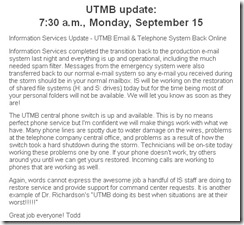I'd never heard of Healwell before and took a look over their offerings. Has anyone used the products? Beyond the…
News 9/17/08
From Rogue: "Re: Epic clients. Children’s Omaha, Fairview, Carilion Clinic, Sisters of Mercy Health System, Ohio State University Medical Center, Children’s Hospital of Philadelphia, Sutter Health, Cleveland Clinic. I cheated – I read the User Group Meeting brochure. Some of the dozens presenting." Thanks to all those who named clients, most of them in the comments to the earlier article asking for some names.
From Pistol Pete: "Re: Adventist. John McLendon, CIO of Bayfront Health System, is leaving to take the CIO job at Adventist Health System. No word on where Tim Thompson landed this time."
From The PACS Designer: "Re: presentation software. Mr. H has posted about TechSmith’s SnagIt being one of his favorite inexpensive software tools for capturing images and text for use elsewhere. TPD has also used SnagIt and has noticed the improvements to another TechSmith software tool called Camtasia Studio 5 that provides for better video presentations. The software would be a good solution for numerous medical image files that require additional annotation of data elements from CT and other modalities." Link. I’m a longtime Camtasia user as well and I agree that it’s just great. I have, in fact, used it to capture and annotate cine loops from PACS as you mentioned. It streams in Flash, so it’s fast and high quality.
From Rudy Washington: "Re: GE. Does anyone have any insights as to the future of GE’s HPA patient accounting system? HPA was originally developed by IDX many years ago. Are they migrating current clients to a new patient accounting system or do they plan to enhance and support HPA?"
Going back to the Misys-Lehman mess, some now-tarnished names were all over the March announcement. Lehman Brothers brought the money and Goldman Sachs brought the advice. I think there’s little doubt that only two outcomes are likely in the few weeks until the scheduled shareholder vote: (a) ValueAct Capital jumps in with the cash, or (b) the deal falls apart completely because conditions are terrible and the merger will be reevaluated in an entirely new and harsher light by both lenders and shareholders. Given a long and nearly unbroken string of Misys incompetence and/or bad luck, I wouldn’t want to bet either way.
Speaking of Lehman, they spent $309 million on IT in the most recent quarter. Other than the bankruptcy thing, I’m sure they’re happy to be Most Wired.
Conditions are are grim in Galveston, but at least UTMB’s IT department gets some nice kudos right on the main hospital web page. Sounds like they did a great job in recovering vital IT capabilities.
I don’t watch HIStalk’s stats too much, but Inga does, so she’s just squirming to have me mention that we’re on track for a record number of page views and visits this month unless everybody stops reading at once. So, please don’t.
The Madison paper runs a pun-laden preview of Epic’s user group meeting, currently underway with 3,900 attendees.
Listening: Hyppio FM, a hard-rocking Helsinki radio station that my little Aluratek thingie turned up. You can click the Listen link on the web page and tune in from there if you don’t have the gadget.
Pete Stark introduces a new HIT bill that would charge the federal government with creating standards and "creation of an open source HIT system that will be made available at little or not cost to providers." Open source expert Roger Maduro sent me this: "There are several sections recommending the use of open source software. It references VistA as a model but it leaves the door open to other open source solutions. This is a very big step for Congress."
Cerner gets its first Latin American customer, a 200-bed hospital in Chile.
Another Indian hospital mob attack: a doctor is assaulted over admission of a patient.
Little Company of Mary (CA) gets a local paper writeup for its medication management systems: smart pumps, a dispensing machine, and a barcoding packager.
I was looking at the results of a survey in which Alan Greenspan was voted most responsible for today’s dire economic conditions. You can ask him about that when he keynotes at HIMSS, at least if we’re not all selling apples on corners by then.
Microsoft may spin poor Vista sales, but actions speak louder than words: they’re already getting ready for developer testing of Windows 7. I’m sure those handful of hospitals actually thinking about rolling out Vista will pass now. I also noticed that MSFT is selling perennial cash cow Office Ultimate 2007 (including Access and Publisher) for just $60 to anybody with a .EDU e-mail address, which seems desperate (it’s a real perpetual license, not a subscription). Maybe they should replace Ballmer with Jerry Seinfeld.
Computer disks full of NHS employee information are lost in the mail while headed off to payroll outsourcer McKesson.
GE Healthcare and Cerner are going after a big PACS contract in Ireland valued at up to $175 million.
Evanston Northwestern Healthcare, convinced by its marketing people that having a sensible, descriptive, and correctly spelled name is so 1990s, "rebrands" itself NorthShore University HealthSystem (they apparently have something against the space). The hospital claims it had "outgrown" its name (huh?) and offers this marketing gibberish as a half-hearted excuse: "The core of the new name/brand is ‘NorthShore,’ according to the firm. NorthShore not only signifies a geographic area — and a much broader terrain than ‘Evanston’ — but also serves as a state of mind. Prestige, quality and a favorable destination are a few of the attributes people say come to mind with the name NorthShore." What NorthShore brings to my mind is painfully obvious attempt at trendiness and a preoccupation with marketing BS. Just do your damned job and patients will show up in droves (the hospital is probably already full, for that matter, making the entire exercise even closer to pointless).
Speaking of rebranding, Dairyland is now Healthland (which we told you earlier). The company also announced the acquisition of Advanced Professional Software (which we told you earlier).
Jobs: Cerner CPOE Consultant, EHR Account Management Associate, Regional Sales Manager – South, Cerner CCL Custom Report Writer. Sign up for weekly job blasts here.
You know this article is going to fun from its subtitle: "Soldiers at the military hospital languished in part due to incompatible databases and dismal record keeping. Welcome to the Pentagon’s $20 billion medical-records boondoggle." It’s critical of AHLTA, saying it should never have been allowed to continue in the presence of the far superior VistA and did so only because of DoD arrogance. It also mentions a couple of things that I reported here long ago: that CHCS II was renamed AHLTA only because nobody could stand it and that former CIO Lt. Colonel Mike Fravell cranked out a $300K system that was better than the $5 billion AHLTA, which got him shipped off to South Korea for questioning the value of fat cat contractors like Northrop Grumman.
I’ve heard no announcement, but according to bid documents, the Mississippi Coastal HIE has chosen Medicity for its proof of concept, six-county RFP, with a three-year value not to exceed $3.5 million.
Who knew that Mayo Clinic is doing a joint venture with a disease management software vendor in the Netherlands?
Idiotic hospital lawsuit: Missouri hospitals are suing American Tobacco for $8 billion, claiming that they should be reimbursed for uncompensated care rendered to smokers.
HERtalk by Inga
Here are some thoughts about the whole Seinfeld/Microsoft/Apple discussion and whether Seinfeld is the right guy to deliver Microsoft’s marketing message. I loved Seinfeld. It was a classic 90s show. If you are over the age of 30, you can probably name all the main characters. Maybe you watched Seinfeld while you were sitting in front of your TV with your new 4.3 lb IBM ThinkPad 701C (50MHz 486DX2, 14.4 kbps modem, 540MB hard drive with 8MB RAM) with its very stable Windows 95 OS. When you see Jerry on those commercials, it just reminds you of those good old days when Bill Gates was first named the world’s richest person. Compare that to Justin Long, the Apple cutie (in a computer-nerd sort of way). Other than the Apple commercials, he is known for some silly movies, including the Dodgeball: A True Underdog Story. If you missed the movie, the basic story line is that the small local gym misfits enter a dodgeball tournament to save the gym from the big corporate health fitness chain. Anyway, with those images in mind, does anyone really think paying millions for Jerry was a genius decision?
Nuance announces the release of Dragon Medical 10, which is said to recognize dictation nearly twice as fast as previous releases and to be 20% more accurate. Also included are new medical vocabularies, improved EMR integration, and regional accent support.
Secure authentication enthusiasts might enjoy this article. After the initial roll-out of its Epic system, Children’s Hospital Medical Center (OH) incorporated both RSA’s Secure ID tokens and Sentillion Identix fingerprint readers for medication prescribing and dispensing.
Pattie A. Clay Regional Medical Center, Princeton Healthcare System, Riverview Hospital, and Frederick Memorial Healthcare System are named 2008 QUEST Award winners. The QuadraMed-sponsored awards honor hospitals for innovative and impressive use of QuadraMed products.
Cerner completes its first sale in Latin America. Clínica Las Condes in Santiago de Chile will implement Millennium at its 220 bed hospital.
HP announces restructuring plans following the EDS acquisition. HP plans a 7.5% staff reduction (24,600 employees) worldwide over the next three years. Nearly half of the cuts will be in the US.
Speaking of layoffs, MedZilla.com reports that in August more than 25,000 new jobs were created in health care, with about 14,000 being hospital-based positions.
CAQH announces that providers now have a source for checking patient deductible balances online, at the point of care, and potentially any health plan. Insurers participating in the voluntary program cover an estimated 130 million lives.
Sounds like the Epic’s user group meeting is quite the affair. The event is following a Much Ado About Healthcare theme and Judy apparently dressed as Portia (of “Merchant of Venice” fame) as she welcomed attendees. Word is that having an extra 3,900 people in Verona caused some traffic snarls. On the agenda: Steven Levitt and Roy Blount, Jr. Meals are under a temporary tent and Epic is running 100 shuttle buses, according to local reports. If you are there, send us a update from the field.
athenahealth extends it business process services agreement with Perot Systems for an additional five years, extending a seven-year relationship.
Next time you need a massage, head over to the hospital. Health Forum, a subsidiary of the American Hospital Association releases a survey indicating that more than 37% of hospitals offer one or more complementary and alternative medicine services, with massage therapy taking one of the top spots.









Can anyone tell me if there is a free/cheap project management software application out there for project planning for those of us who don’t want to use (or can’t afford) Visio, MS Project or others?
Inga- in regards to Nuance’s DNS10 software, we should remind readers that Nuance is trying to force docs to use the expensive DNS10 Medical by disabling the use of DNS10 non-Medical versions when a user tries to use these less expensive softwares with a popular EMR. This has made most docs irate and they are demanding that Nuance change this outrageous policy immediately.
Regarding VA’s VISTA EMR program, has anyone compared it to any of the top 10 (or 20) commercial EMR programs ? It is pretty weak and clunky, but compared to the AHLTA DoD software it is great. What’s that old saying..”In the land of the blind, the one-eyed man is king.” and regarding the MISYS/Allscripts mess–afraid this is the end of MISYS very soon.
Re: Quest awards. Wasnt Princeton one of the last institutions to actually buy Misys CPR (before Quadramed took over)? Maybe they should have had a separate category for Misys vs Affinity users… Interesting that they do not mention any HHC hospitals, since that was Misys’s biggest client (must be upset that HHC is looking for a new EHR system).
Re Pete Stark’s new healthcare IT bill, check out the front page article in yesterday’s Healthcare IT News for more detailed coverage and insightful comments by Justin Barnes, VP Greenway Medical and Chairman of the EHR Association. http://www.healthcareitnews.com/story.cms?id=9983
Cowgirl:
Thank you for your reference. You have to understand that the EHRA is a vendor group put together for lobbying purposes to promote the use of expensive “enterprise” EHR systems in healthcare. Naturally, he does want CCHIT to be mentioned- it’s the “certification” product promulgated by EHRA/HIMSS to drive competing inexpensive EMRs out of the market. He also is against any mention of government backing “open source” EMRs as this will bring a competitive force like no other, making the survivability of these albatross EHR softwares difficult.
At the minimum, it could serve to bring down prices, which is good for everyone else involved in healthcare.
Al
Inga may be pleased to know that her comment about Judy got center billing during Carl’s presentation this morning at Epic’s UGM. Rumors of traffic congestion are grossly overrated. The weather is great, although why we needed to have a bonfire at midday, I have no idea….
Regarding Evanston Northwestern name change, agreed the new name smacks of a marketing team exposed to too much nitrous. But once the 78 year old ties to Northwestern were severed and the University of Chicago “at the forefront of medicine” took their place, you have to have a name to remind folks just how brilliant (? trendy, ? elitist) they are…
Don’t think there is any secret about Tim Thomson. He is in the driving seat at The Methodist Houston Health System per a recent CHIME Profile.
Dr. Borges, with all due respect, I probably know more about EHRA than you do. Cumulatively, member companies have spent thousands of FTE hours doing volunteer work with HITSP, HISPC, CCHIT and other meaningful initiatives. If you think that these companies pay staff to participate, you’re sadly mistaken. These are individuals with other responsibilities who understand the importance of participating in work that will redefine our industry. And if you believe that “free” software will deliver the functionality and benefits that EHR vendors tout, I’ve got a bridge I’d like to talk to you about. Certainly, be cautious and hold your vendor to high standards. But, while “market forces” appear to be failing in other sectors, I believe that in the HIT market, vendors can deliver more value than skeptics might believe.
Inquiring Minds Want to Know: Free and Cheap Project Management Software
If you are looking for industrial strength software, OpenWorkbench fits the bill. http://www.openworkbench.org/ It is like project (fat client) with a few scheduling differences that actually should drive more organizations to use the tool. It is really geared towards managing a single project or group of small inter-related projects.
Web based alternatives are a better choice if you are interested in more collaboration and centralized management. They also may be a better depending upon how you staff or schedule resources. THIS IS A KEY POINT. Also, take into account what-if’s and reporting. Workbench is better IMHO when you are making broader estimates and then deciding to allocate staff to it.
Computer Associates (CA) bought out the underlying company and posted the software for open source, then has focused their new development efforts of aggregating the information from individual projects in the fat client application. Pretty creative strategy for CA. I have used it. It is workable.
GANTTProject is another open source project. It is workable and less sophisticated. This is good for many people and for the way many people manage. I have used it on a few small projects. It worked fine. I do not know if it would work as well on a large initiative with many inter-related parts. It is not as collaborative as you may need to be. For being a fat client Java app, it is pretty fast. It stores data in XML which is interesting if you like to dabble and want to write some aggregation reports yourself.
For a web-based system, I used dotProject on one small initiative. It is PHP and MySQL-based. It was also workable. It is good for small development projects as it is really geared towards collaboration. The integration of ticket tracking is slick if you are assigning features for development or for test issue resolution. Again, it depends upon how you want to schedule and your approach.
Search-around – there are some Excel-based basic project management planning tools as well. They work fine if you are really managing at higher levels and on individual projects.
Good luck
Grizzled Veteran – Re: VistA – I looked at it a 5 years or so back in the form of OpenVistA when there were some discussions as to the role of WorldVistA and others coordinating the efforts. The install was very clunky. The application had some good points –
~Order Entry in the product was integrated
~Order Entry from documentation was solid
~Medical terminologies could be pretty well managed
~It was responsive and generally information was integrated
~Interface specifications were defined and documented
The bad points –
~Aggregate reporting was tricky
~Pharmacy and the ancillaries were pretty bad
~Inconsistencies in the user interface and user conventions between modules
~Developer documentation was not the best but the on-line community was great
~Some of the user interface conventions were not well suited to both ambulatory and hospital-based operations
~Some modules were neutered from what I saw at the VA – medication administration and some portions of PACS
~Workflows and some functions that were not aligned with ambulatory operations
Some of these points have been addressed (ex: ambulatory functionality, PACS) while others are still there.
Dear Cowgirl:
Thank you for your rebuttal!
>>> I probably know more about EHRA than you do.
Hmmm… I’m not to sure that. Before 2006 I knew nothing CCHIT, but then when the initial certification criteria was published I was both shocked and dismayed. I’ve been writing and complaining about this organization ever since. The way I see it may not only stifle competition to inflate prices, but those involved should be prosecuted by the full extent of law for breaking the RICO anti-racketeering statutes. What CCHIT does is no different than a mobster extorting money from businesses which in this case would be vendors to allow them to compete in society. What prevents any prosecution of CCHIT is the fact that President Bush and Health and Human Services Secretary Leavitt have wrongly backed CCHIT insulating this entity from the needed legal oversight.
CCHIT offers a concept that superficially looks like a good thing. Once you look at the whole forest rather than individual trees one sees the obvious fact that what is occurring here is that EHRA is trying to corner the market through its high certification fees by making it extremely difficult for its smaller competitors to survive. These smaller companies make up both the free and inexpensive EMR market. EHRA has ingeniously brought this on through its heavy lobbying efforts of Congress, other elected officials, and even a few physician organizations. It set up CCHIT as a not-for-profit entity and has obfuscated what is really happening by calling for “volunteers” and aligning its sister organization, HIMSS, with a couple of true not-for-profit groups.
The volunteers may consists of a few who religiously feel that this is an honorable way to affect our nation’s health system, but frequently, as you stated in your note, they represent the very member companies of EHRA which stand to make an enormous profit if other EMR vendors are eliminated from the marketplace. One such volunteer is the CEO of e-MD’s, David Winn MD, who worked as a volunteer to see how CCHIT was going to affect his company and by participating he hoped to get an early fix on what they needed to do to pass the tests be certified.
Since 2004 I have participated in numerous threads at a website called http://www.emrupdate.com, discussing some medical cases, but also a lot of programming and politics, the latter including CCHIT, pay-for-performance and e-prescribing and have posted over 4100 times concerning these topics. I have written to numerous members of Congress, to the FTC, as well as to the press about what is happening. I have a website (www.msofficeemrproject) that not only offers a free Microsoft Office EMR for download but also has numerous downloads that concern the politics of HIT. One particular download is a PowerPoint presentation called “What Has Gone Wrong with the Direction of the HIT in the USA?” (http://www.msofficeemrproject.com/Page3.htm) which has been downloaded over a thousand times and has been made into hard copy and distributed to members of Congress on 12/21/2007 just prior to the vote to attach HIT mandates to a physician pay reduction fix. You will note that although the HIT mandates were attached to the bill to prevent Bush from vetoing it, the $5 billion dollar funding was mysteriously removed at the last minute…
At my website you will also see the original CCHIT not-for-profit incorporation papers which state that at the end of the year (2006) all profits will be distributed to those vendors which were the original founders. The also downloadable 8/2006 monthly minute notes clearly stated that by Christmas, 2006 they would have over $1 million of profit. Doesn’t take much know-how to do the math! Soon after I made light of these issues the monthly minute note publications were suspended and then restarted on 11/2006 in a more concise, scrubbed, generalized matter. CCHIT’s not-for-profit status was later reorganized on 12/2006.
>>> Certainly, be cautious and hold your vendor to high standards. But, while “market forces” appear to be failing in other sectors, I believe that in the HIT market, vendors can deliver more value than skeptics might believe.
If you download and look at the slideshow (“What Has Gone Wrong with the Direction of the HIT in the USA?”) you will come to understand that CCHIT certified EMRs generally cost twice as much as those that are not certified, forcing purchasers to put more money at risk. You also see a recent CDC biannual report (pub on 11/2007), it found that although the uptake of EMRs in general has increased almost 30%, you will see that they found that the growth of expensive CCHIT certified EHR systems has statistically stagnated- physicians aren’t buying into this “added value” (i.e. BLOAT). This slideshow has references to the fact that although CCHIT promises to “assure” doctors, just in 2008 several CCHIT certified EHR systems have seen their stocks decline, have undergone restructuring, have been bought out, and/or have gone out of business altogether. A quick synopsis of this activity is highlighted in my download called the “CCHIT Hall of Fame” (some call it “Hall of Shame”…), downloadable at the same page noted above. If you look at the high deinstallation rate of expensive CCHIT certified EMRs of between 20% to 40% due to the complexity of the software, this makes the overall cost even higher.
So I don’t know where you got the idea that CCHIT’s “high standards” has prevented the failing of the EHR sector. This summer some of the CCHIT-vendor companies have shown some improved market strength, but that was mostly due to speculation on the misguided e-prescribing mandates passed on 7/2008. I’m sure that their stocks will plummet again in the next 3-6 months when reality sets in.
What CCHIT offers physicians are not high standards but the technological capability which can eventually be used by insurance industry and the government against physicians to eventually pay them less while having them work more through a process called “data mining”. These EHR systems which supposedly offer artificial intelligence and decision-making support will pave the way for the day in which insurance companies and the government will pay nurses and physician assistants to see patients as if they were doctors. Doctors aren’t stupid- they will continue to reject high priced CCHIT-certified EHRs for many years to come.
BTW, I trust my vendor since my vendor is ME!!! I first programed my EMR back in 1990 using Paradox for DOS and by 1995 due to the popularity of Windows I changed to the MS Access platform. It’s been a rewarding endeavor from day one and has been a both inexpensive and powerful solution that runs my office- EMR, oncology, and PMS.
I believe that what is happening in Congress is that our representatives are beginning to see that even with their touted 2% incentive to use e-prescribing, very few docs have signed on for e-prescribing and for the use of CCHIT-certified EHR systems. They are trying to do what they should have done from the beginning- rely on low cost alternatives, simplify the process, and make HIT truly a worthwhile investment for a physician’s time and efforts. The practitioner should NOT have to pay for this technology in which he has the least to gain.
Cheers,
Al